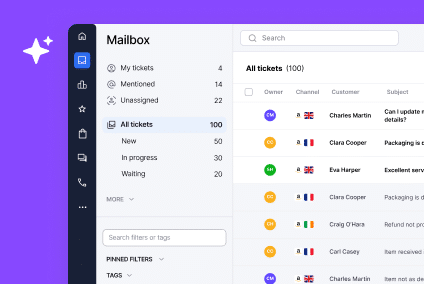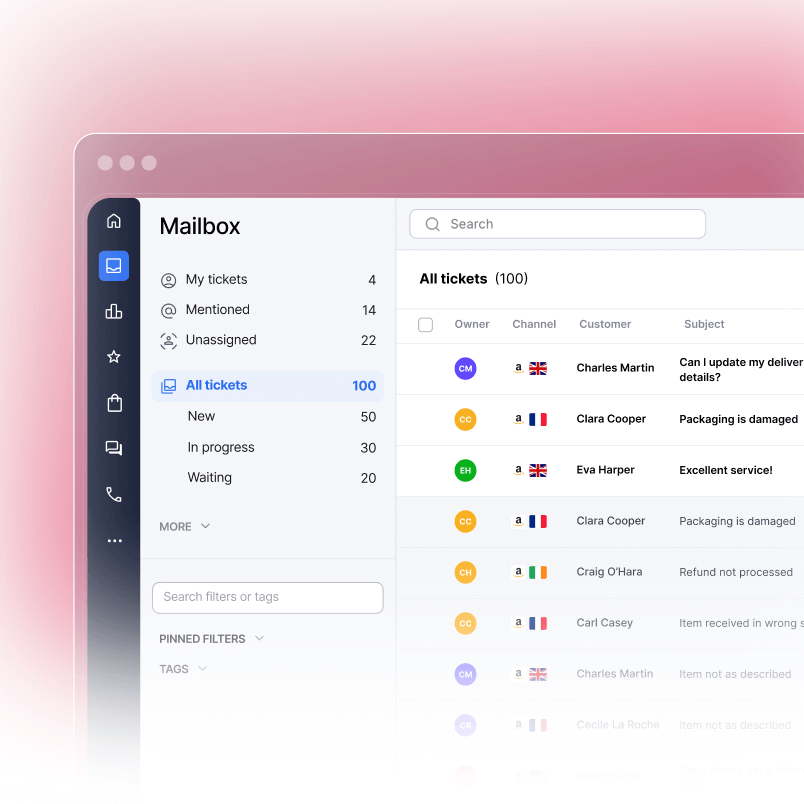Your support team is drowning. Every day, your agents answer the same questions over and over: „Where’s my order?“ „How do I reset my password?“ „What’s your return policy?“ These repetitive tickets waste time and burn out your team.
A well-structured knowledge base stops this before it starts. When customers find answers themselves, support tickets drop by up to 40 percent. This guide shows how to build a self-service hub that answers questions before customers reach your team, deflects repetitive tickets, and turns your support operation into a productivity machine.
Research shows that knowledge bases reduce support costs by 30 to 40 percent when implemented effectively, and 60 percent of customers prefer self-service support over live chat. You’ll learn the structure, content strategy, setup steps, and tactics that turn documentation into a CX powerhouse.
How a Knowledge Base Fixes Your Support Problem
Your support team handles the same five questions dozens of times per week. A customer asks about shipping. Another asks about returns. A third needs password help. Each ticket takes five to ten minutes to resolve, and your agents are frustrated.
Here’s what happens when you launch a knowledge base: customers search for answers before emailing support. They find step-by-step guides, FAQs, and troubleshooting articles. They solve problems themselves. Your support volume drops.
This isn’t theoretical. Brands that implement knowledge bases see measurable results within 30 days. One ecommerce brand saw a 38 percent drop in ticket volume one month after launching an FAQ widget. Another deflected 1,200 repetitive order status questions in a single month by publishing tracking guides and status explanations. You can reduce WISMO (Where Is My Order) tickets specifically using a dedicated knowledge base focused on order tracking and shipping information.
The math is simple. If your team handles 500 tickets monthly and 40 percent are repetitive, a knowledge base removes 200 tickets from your queue. At 7 minutes per ticket, that’s 23 hours your team gets back each month. Your agents focus on complex issues that need human judgment. Your customers solve easy problems themselves.
Why Knowledge Bases Actually Work for Support Teams
Most customers now prefer to solve issues on their own. In fact, 61% of customers would rather use self-service resources for simple problems instead of contacting live support. They don’t want to wait in a queue for an agent — they want fast, direct answers.
A knowledge base gives customers that option. They search your help center at 2 AM, find the answer, and move on. No waiting. No back-and-forth emails. No frustration.
This benefits your team in four ways.
Repetitive tickets disappear. The same question stops eating up your time. Password resets, account questions, shipping inquiries, and refund policies are answered by your documentation, not your inbox.
Customer satisfaction increases. Self-service responses are faster than agent responses. Customers get help instantly. CSAT scores improve because wait times drop and customers feel they have control.
Agent productivity climbs. Your team spends less time on routine issues and more time on complex problems that need creativity and judgment. Job satisfaction improves because your agents aren’t repeating themselves.
Your support scales without hiring. As your business grows, you don’t need to hire proportionally more support staff. Your knowledge base scales with you. Ten thousand new customers still get answers through your documentation.
How to Build a Knowledge Base Structure That Works
The best knowledge bases are organized logically and easy to navigate. Here’s what effective structure looks like.
Your homepage should feature a prominent search bar. Customers land on your help center and immediately know they can search. Below the search bar, display your most popular topics in clear categories. Group articles by function: pre-sale FAQs, product guides, account help, returns and refunds, troubleshooting.
Content hierarchy matters. Start broad, then narrow. A category for „Shipping“ contains articles like „How long does delivery take?“ and „Can I track my order?“ A category for „Returns“ contains „How do I start a return?“ and „What’s your return window?“ Each article answers one specific question clearly.
Format articles for skimming. Use short paragraphs, never longer than three sentences. Break up text with subheadings and bullet lists. Customers read help articles quickly, looking for the specific answer. Walls of text lose readers.
Include feedback buttons on every article. „Was this helpful? Yes / No“ data tells you which articles work and which ones need updating. This feedback drives continuous improvement.
Add visual elements. Screenshots show users exactly what they’re looking for. Video walkthroughs of account setup or product configuration reduce written complexity. Charts and diagrams clarify processes. Visuals reduce confusion and speed up comprehension.
What Content Your Knowledge Base Needs
Start with the questions your support team answers most. Review your ticket history from the past three months. Which issues appear most frequently? Those become your first articles.
Your knowledge base should cover these categories.
Pre-sale FAQs answer questions before customers buy. „What’s your return policy?“ „Do you ship internationally?“ „What payment methods do you accept?“ „Is this item in stock?“ These articles prevent purchase hesitation and buyer’s remorse.
Product how-tos show customers how to use what they bought. If you sell software, include account setup, feature explanations, and workflow guides. If you sell physical products, include sizing guides, assembly instructions, and care information.
Account and login help covers password resets, account recovery, profile updates, and subscription management. This category typically drives high ticket volume, especially after system changes.
Returns and refunds information answers „How do I start a return?“ „What’s your refund timeline?“ „Can I exchange instead?“ and „What if my item arrived damaged?“ This content prevents escalations and reduces customer frustration.
Platform-specific issues apply to your marketplace. If you sell on Amazon, include Amazon-specific guidance. If you’re a Shopify store, explain Shopify-specific setup. If you’re a SaaS company, document API integration, user permissions, and troubleshooting.
Technical support focuses on bugs, errors, and problems. „Why won’t my page load?“ „What does this error message mean?“ „My download isn’t working.“ Clear troubleshooting sequences resolve these before customers contact support.
Start with your top 20 to 30 articles in these categories. You don’t need 500 articles to see results. Focused, high-quality content beats scattered, thin coverage.
Picking the Right Knowledge Base Software
You have options. Some knowledge base platforms are standalone. Others integrate into your existing support stack. The right choice depends on your tech stack and support setup.
HelpDocs and Document360 are dedicated knowledge base platforms built for comprehensive documentation. They excel at search optimization, custom branding, and analytics. Best for teams that want a full-featured KB separate from other tools.
Shopify stores benefit from built-in help center features or helpdesk platforms designed for Shopify. Notion works well for small teams that want lightweight documentation with minimal setup. BigCommerce offers help center functionality within the platform.
If you use eDesk or similar support platforms, check if they include integrated help center or KB capabilities. Many all-in-one support tools include basic KB features that connect with your ticketing system.
Intercom and similar platforms embed help articles directly in live chat. Customers see relevant articles before or instead of opening a chat. This approach reduces chat volume by offering self-service at the moment of need.
Your decision framework: Does the tool integrate with your current support software? Does it offer analytics showing which articles reduce tickets? Can you track deflection rates? Does the search function work well? Can your team maintain it without technical expertise?
Test two to three platforms with your team before committing. Most offer free trials. Spend a day building out three sample articles in each platform. See which one feels easiest to use and maintains best.
Optimization Tactics That Drive Real Ticket Deflection
Launching a knowledge base is just the start. These tactics maximize your deflection rate.
Use actual support tickets as source material. Review your last 100 tickets. The exact language customers use in tickets is the language they’ll search for in your help center. If customers email asking „where is my stuff,“ create an article titled „Track Your Order“ with a subheading „Where is my stuff?“ Match customer language exactly.
Add keywords customers actually search for. If you notice customers searching „how long does shipping take“ more than „delivery timeline,“ use that phrasing in your article title and opening paragraph. Search behavior reveals customer intent better than your own assumptions.
Embed article links in your support macros and autoresponders. When your team responds to a ticket, include links to relevant articles. This teaches customers that your help center has answers while speeding up agent responses. Over time, customers discover the help center before emailing.
Refresh outdated articles monthly. Set a calendar reminder to review articles quarterly. Update timelines, links, and screenshots. Remove information that’s no longer accurate. Stale content damages credibility and fails to deflect tickets.
A/B test article formats and CTAs. Try different headline styles, content lengths, and call-to-action placement. Data shows which formats drive more engagement and faster comprehension. Iterate based on what works.
Link articles to each other. If someone reads „How do I reset my password?“, link related articles like „How do I update my profile?“ and „What if I forgot my username?“ Internal linking increases engagement and helps customers discover more help without leaving your center.
Measure everything. Track search queries. Identify search terms with zero results. Those gaps represent opportunities for new articles. Monitor which articles get the most views. Double down on what works. Retire articles nobody reads.
How Real Brands Cut Tickets by 40 Percent
The 40 percent reduction is not hypothetical. Real ecommerce and SaaS businesses have achieved it.
One multi-channel seller implemented an FAQ widget on their website and saw ticket volume drop 38 percent within 30 days. The widget appeared on product pages and checkout, surfacing relevant FAQs before customers needed to email support.
Another brand created a dedicated help center focused on their top 10 customer issues. Returns, shipping, and account help dominated. After launch, they tracked which articles got clicked. They noticed 1,200 order status questions arrived monthly. They created a detailed tracking guide explaining how to interpret shipping status updates. Within 60 days, tracking inquiries dropped 50 percent as customers self-served through the guide.
A SaaS company saw similar results. They documented their API integration process, user permission model, and common configuration errors. New customers discovered these articles before contacting sales or support. Pre-sale ticket volume dropped 35 percent. Support tickets for basic configuration questions dropped 42 percent.
These outcomes share a pattern. The brands started with their actual support data. They didn’t guess what customers needed. They looked at what customers asked. They documented those answers. They measured impact. Results followed naturally.
Getting Started Today
You don’t need perfect documentation to start. You need useful documentation.
Week one: Review your last 100 support tickets. Identify the 10 most common questions. These become your first 10 articles.
Week two: Draft articles answering those 10 questions. Write as if explaining to a customer, not an internal document. Use the language your customers actually use. Include screenshots or diagrams where helpful.
Week three: Choose your knowledge base tool. Publish your 10 articles. Add a search bar prominently to your website. Tell your support team to link customers to relevant articles.
Week four: Measure. Track how many customers view each article. Monitor which support tickets reference your KB. Count how many customers search your help center. Use this data to improve.
From there, expand. Create 5 new articles every two weeks based on tickets that still arrive. Refresh underperforming articles. Link high-traffic articles together.
Most teams see measurable deflection within 30 days of launch. Your first 10 to 20 articles won’t be perfect. That’s fine. Publish, measure, improve, repeat.
FAQs
What is the best knowledge base software for ecommerce?
The best KB software for ecommerce depends on your platform. Shopify stores benefit from built-in help center features or helpdesk platforms designed for Shopify. Sellers on Amazon or eBay benefit from platforms that offer multi-channel integrations. Multi-channel sellers need a KB that connects with a unified ticketing system. Test tools with your specific use case before committing.
How do I know if my knowledge base articles are working?
Monitor three metrics: search volume, article views, and deflection correlation. Track which articles get the most searches and views. Compare your support ticket volume before and after article publication. If a specific article launches and related tickets drop, your article is working. Most platforms include analytics dashboards showing these metrics.
How many articles should I start with?
Start with 10 to 20 high-impact articles answering your most frequent support questions. Depth beats breadth early. Ten thorough, accurate articles drive more deflection than 100 thin, poorly written ones. Expand based on ticket patterns.
Can I integrate my knowledge base with my chat, email, and ticketing system?
Yes. Most modern knowledge base platforms integrate with major support tools. eDesk, for example, can integrate KB functionality into your support workflow. When customers contact you, agents can reference KB articles in their responses. This bridges self-service and human support seamlessly.
Is a knowledge base right for my business?
If you answer the same questions repeatedly, a knowledge base reduces that friction. If your customers prefer self-service, a KB serves them better. If you want to improve support efficiency without hiring, a KB scales your team. If you handle support requests in any volume, a knowledge base improves your operation.




